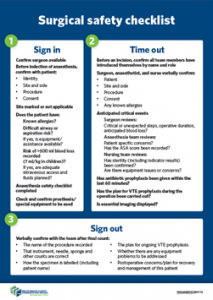Since 2012 the Commission has been encouraging all hospitals to use the Surgical Safety Checklist (the checklist). The checklist, developed by the World Health Organization (WHO), is a common sense approach to ensuring the correct surgical procedures are carried out on the correct patient.
 The Commission is encouraging the use of a paperless checklist as part of the roll-out. Theatre teams use a large poster-sized version of the checklist on the wall of the operating theatre.
The Commission is encouraging the use of a paperless checklist as part of the roll-out. Theatre teams use a large poster-sized version of the checklist on the wall of the operating theatre.
This is about refining the current use of the checklist, rather than a completely new activity. The checklist is not meant to be used as a ‘tick-box’ exercise – it is meant to ensure that the team performs key safety checks as a team, without having to rely on memory, increase verbal communication in the operating theatre and instil a sense of shared accountability for the outcome of the procedure. Having the checklist on the wall allows all members of the team to see what will be asked and use it as a discussion guide for all three parts (sign in, time out and sign out).
The WHO estimated in its 2007–08 pilot study of the checklist that worldwide implementation would prevent at least half a million deaths per year; new studies have now confirmed these results. Data collected from their study, completed in 2009, showed decreases in patient mortality (from 1.5 percent to 0.8 percent) and inpatient complications (from 11 percent to 7 percent).
Many studies on the effectiveness of surgical safety checklists have been undertaken, with most showing reductions in surgical mortality and complications. A 2014 systematic review of 16 studies noted that checklists ‘have been shown to significantly improve patient outcomes subsequent to surgery, and therefore their use is being widely encouraged and accepted’.
Studies and local experience have shown improvements when different team members lead the three parts of the checklist. There is more team engagement and appropriate team members are present. We recommend the:
- anaesthetist leads sign in
- surgeon leads time out
- nurse leads sign out.
The programme has developed a checklist for use in operating theatres. This shows the minimum items to discuss during sign in, time out and sign out. Some hospitals have developed their own versions and have agreed to share these.
- Health Quality & Safety Commission checklist
- Auckland DHB checklist
- Southern Cross checklist
- Waitemata DHB checklist
